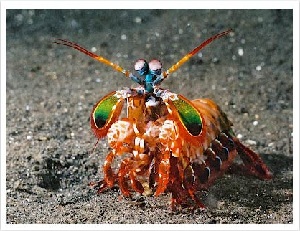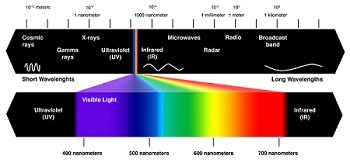I came across an interesting (and somewhat disturbing!) info-cartoon in The Oatmeal about an unusual creature, the MANTIS SHRIMP.

The fascinating part to me is that the creature has an extraordinary potential for color vision which completely dwarfs our paltry human spectrum.
This post raised some questions on the nature of color vision. If an object is in a color that we don’t have color sensitive cones for, what color would we see it in?
We only see light within the so-called “visible light spectrum.” This is because our photoreceptors (rods and cones) are stimulated by light which has a wavelength between around 360 nm and 720 nm. This image shows the visible light part of the spectrum in relation to the whole “Electromagnetic Spectrum.”
It is completely possible for other creatures to be able to DETECT light beyond those points.
Each photoreceptor is incapable of color discrimination, however. Light at some wavelengths is easier to detect, so a single cone may detect one wavelength as brighter and another as dimmer. (This is why people who are “color blind” see reds as various shades of grey.)
In order for us to discriminate between colors, the cones are paired for processing of information. The combination of the responses (brightness/dimness) of different cones results in our appreciation of color.
So, think of the butterfly as being able to detect light over a larger spectrum than visible light (going into UV for sure), and with greater quality differences where humans may see two colors as being a “close match.”
For an intriguing discussion on color, you may enjoy downloading this RadioLab podcast! http://www.radiolab.org/2012/may/21/



Leave a Reply